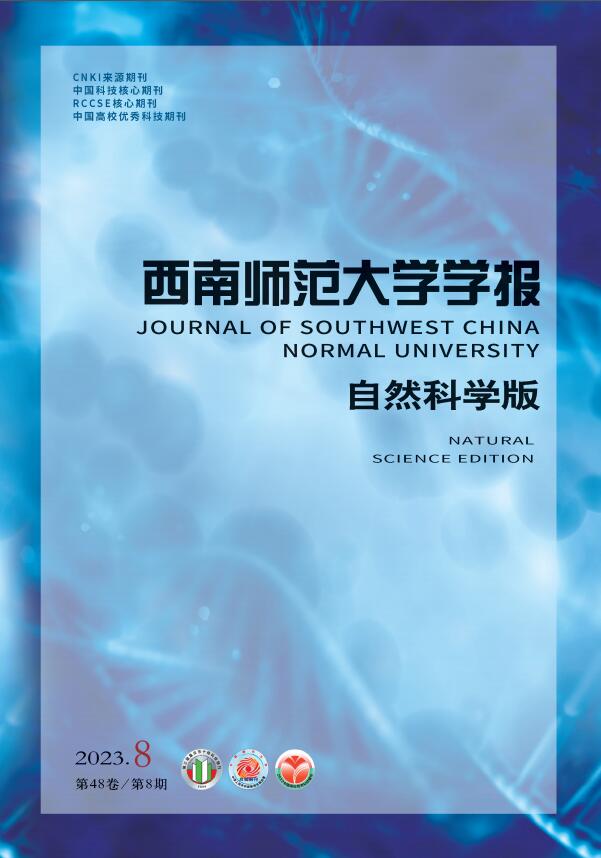HTML
-
文献[1-2]引入了有周期边界的一维确定型Kuramoto-Sivashinsky(K-S)方程作为反应扩散系统中湍流和波传播的一维模型. 文献[3-4]研究了确定型K-S方程. 文献[5-9]和文献[10]分别研究了Wiener噪音和Lévy噪音下的随机K-S方程. 本文主要研究带有乘法噪音和彩色系数的随机K-S方程
其中
$ t \geqslant \tau \in \mathbb{R}$ ,α>0,$ D=\frac{\partial}{\partial x}$ ,f是依赖于时间和空间的外力项.$W_t=W(t, \omega) $ 是概率空间(Ω,$\mathscr{F} $ ,P)上的双边实值Wiener过程,$z\left(\theta_t \omega\right) $ 是一个彩色噪音,$\alpha u \circ \mathrm{d} W_t $ 表示Stratonovich积分意义下的乘法噪音.设状态空间为
本文主要研究其对应的奇空间
上的后向紧拉回随机吸引子的存在性. 勒贝格空间H0被赋予通常的L2范数
$ H_{\mathrm{per}}^2(G)$ 为G上由周期函数构成的索伯列夫空间,记$ V=\dot{H}_{\mathrm{per}}^2(G)=H \cap H_{\mathrm{per}}^2(G)$ ,其奇空间为V0=H0∩$H_{\mathrm{per}}^2(G) $ . 索伯列夫空间V0上的范数为$\|u\|_{v_0}=\left\|D^2 u\right\|_{H_0} $ ,内积为$(u, v)_{V_0}=\int_G D^2 u \cdot D^2 v \mathrm{~d} x $ (见文献[11]).令(Ω,
$ \mathscr{F}$ ,P)为标准的Wiener空间,其中$ \mathscr{F}$ 是Ω上由紧开拓扑诱导的博雷尔-σ代数. P是(Ω,$ \mathscr{F}$ )上的双边Wiener测度.$ \left\{\theta_t: \varOmega \longrightarrow \varOmega\right\}$ 为一族保测自变换,$ \theta_t w(\cdot)=\omega(t+\cdot)-w(t)$ . 于是得到一个遍历度量动力系统(Ω,$ \mathscr{F}$ ,P,(θt)$ t \in \mathbb{R}$ ). 取W(t,·)是恒同算子,即满足W(t,ω)=ω(t),$ \forall \omega \in \varOmega$ (见文献[5, 12-14]).对于非自治动力系统(1),为了研究其长时间动力行为,我们关注其生成的拉回随机吸引子
$ \mathscr{A}(\tau, \omega)$ (见文献[12, 15]). 由于在H0或V0上,方程(1)的解满足$u(t, -x)=-u(t, x) $ ,因此$\mathscr{A}(\tau, \omega)$ 由奇函数组成,这样的吸引子被称为奇吸引子. 在本节,我们取集族$ \mathfrak{B}$ 由H0中所有后向缓增的双参数集$\mathscr{B} $ 构成,其中$\mathscr{B} $ 为此外称双参数集
$\mathscr{B} $ 是后向紧的,如果$\mathscr{B} $ 是紧的并且对每个时间$ \tau \in \mathbb{R}$ 和样本ω∈Ω,$ \bigcup\limits_{s \leqslant \tau} \mathscr{B}(s, \omega)$ 是预紧的. 这样的$\mathscr{B} $ 对应生成的$ \mathfrak{B}$ -拉回随机吸引子称为后向紧随机拉回吸引子.我们考虑如下的变量变换:
其中
$-\frac{a_1}{{\rm{ \mathsf{ π} }}} \sum\limits_{k=1}^M \frac{1}{k} \sin \frac{2 k {\rm{ \mathsf{ π} }} x}{l}=\xi(x) \in \dot{C}^{\infty}(-l, l) $ 是H0和V0之间的桥函数,$M=M\left(a_1, a_2, l\right)>0 $ 是一个足够大的数. 显然ξ(x)是奇函数,且对任意a1,a2>0,w∈V0有[5]随机变量
$ z\left(\theta_t \omega\right)=-\int_{-\infty}^0 \mathrm{e}^s \cdot \theta_t \omega(s) \mathrm{d} s$ 是一维随机微分方程$\mathrm{d} z+z \mathrm{~d} t=\mathrm{d} W(t) $ 的稳定解,被称为Ornstein-Uhlenbeck(O-U)过程或彩色噪音,有如下性质(见文献[5, 12-13]):存在θ-不变满测集$\widetilde{\varOmega} \in \varOmega $ ,使得对任意$\omega \in \widetilde{\varOmega} $ ,有$t \longrightarrow z\left(\theta_t \omega\right) $ 连续,且对任意λ>0,有对任意
$ \omega \in \widetilde{\varOmega}$ (仍记$ \widetilde{\varOmega}=\varOmega$ ),方程(1)在(2)式的变换下可重记为关于$v\left(t, \tau, \omega, v_\tau(x)\right) $ 的方程引理1 对
$ f \in L_{\text {loc }}^2\left( { \mathbb{R}, } H_0\right)$ 和任意的vτ∈H0,$ \tau \in \mathbb{R}$ ,ω∈Ω,方程(5)在H0中存在唯一的弱解$ v\left(s, \tau, \omega, v_\tau\right)$ 满足$v\left(\cdot, \tau, \omega, v_\tau\right) \in C\left(\tau, +\infty ; H_0\right) \cap L_{\text {loc }}^2\left(\tau, +\infty ; V_0\right), v\left(\tau, \tau, \omega, v_\tau\right)=v_\tau \in H_0 $ . 此外,$\tau\left(s, \tau, \omega, v_\tau\right) $ 连续依赖于s,τ,vτ,且关于样本ω∈Ω可测.类似文献[3-5, 7],可以用标准的Faedo-Galerkin方法证明方程(5)在奇空间H0∩V0上解的适定性. 因此由方程(5)的解可以定义一个协循环Φ:
$ \mathbb{R}_{+} \times \mathbb{R} \times \varOmega \times H_0 \longrightarrow H_0$ ,使得对任意(t,τ,ω,vτ)∈$ \mathbb{R}_{+} \times \mathbb{R}$ ×Ω×H0,有其中初值
$ u_\tau=\mathrm{e}^{\alpha z(\omega)}\left(v_\tau+\xi(x)\right)$ . Φ关于t,τ,uτ是三元连续的,且关于ω∈Ω是可测的.
-
为了得到K-S方程(5)的解的后向一致估计,我们给出外力项f(t,x)和噪音系数α的一些合理假设.
假设1 存在某个常数c0 < +∞,使得噪音系数0 < α≤c0.
事实上,α可以看作一个控制方程(1)中噪音项增长速度的常数. 若没有特殊说明,c为任意常数.
假设2
$f \in L_{\mathrm{loc}}^2\left(\mathbb{R}, H_0\right) $ 是后向缓增的,即对任意λ>0,τ∈$\mathbb{R} $ ,有显然F(λ,·)是增函数. 若f后向缓增,则f是缓增的,且
引理2 若假设1、假设2成立,则对任意的τ∈
$\mathbb{R} $ ,ω∈Ω和$\mathscr{B} $ ={$\mathscr{B} $ (τ,ω)}∈$ \mathfrak{B}$ ,存在T=T($\mathscr{B} $ ,τ,ω),使得对所有t≥T,us-t∈
$\mathscr{B} $ $\left(s-t, \theta_{-t} \omega\right) $ 一致成立. 其中证 在方程(5)两端同时乘
$2 v\left(r, s-t, \theta_{-s} \omega, v_{s-t}\right) $ ,并关于x∈G积分,有记
$\|\cdot\|_{H_0}=\|\cdot\| $ . 利用Young不等式$a b \leqslant \frac{\eta a^2}{4}+\frac{b^2}{\eta}(\forall \eta>0) $ 和Gagliardo-Nirenberg插值不等式$ \|D u\|_{L^2} \leqslant\|u\|_{L^2}^{\frac{1}{2}} \cdot\left\|D^2 u\right\|_{L^2}^{\frac{1}{2}}$ ,得到再由分部积分法,有
$ 2(\xi D v, v)=-(v D \xi, v)$ ,于是$2(D(\xi v), v)=(v D \xi, v) $ . 下面由假设1和ξ的连续性对(10)式的右边项进行估计:则(10)式可放缩为
在(3)式中取
$ a_1=\frac{2}{\eta}+4+2 \alpha(E|z|+1)>0$ ,$a_2=\frac{\eta}{2}>0 $ ,于是(11)式可转化为由(4)式知
$ 1+2 \alpha(E|z|+1)=\beta<+\infty$ . 将(12)式乘$ \mathrm{e}^{\beta(r-(s-t))-\int_{s-t}^r 2 \alpha\left|z\left(\theta_{\tilde{r}-s} \omega\right)\right| \mathrm{d} \tilde{r}}$ 并关于r∈[s-t,s]积分,有通过变换
$ u(s)=u\left(s, s-t, \theta_{-s} \omega, u_{s-t}\right)=\mathrm{e}^{\alpha z(\omega)}\left(v\left(s, s-t, \theta_{-s} \omega, v_{s-t}\right)+\xi\right)$ ,并借助(a+b)2≤2a2+2b2,有其中
$ \left\|v_{s-t}\right\|^2 \leqslant c \mathrm{e}^{-2 \alpha z(\theta_{-t} \omega)}\left\|u_{s-t}\right\|^2+c$ ,If为f的相关项,I1为f的无关项.由(4)式,存在某个T0=T0(ω)>0,使得对任意t≥T0,有
于是
又根据
$ \lim \limits_{t \rightarrow+\infty} \frac{\left|z\left(\theta_{-t} \omega\right)\right|}{|-t|}=0$ ,于是对任意ε>0,存在某个T1,使得当t≥T1>0时有若取
$\varepsilon=\frac{1}{4 \alpha} $ ,则$-2 \alpha z\left(\theta_{-t} \omega\right)<2 \alpha \varepsilon t=\frac{t}{2} $ ,从而当t +∞时,$ \mathrm{e}^{-t} \mathrm{e}^{-2 \alpha z(\theta_{-t} \omega)}<\mathrm{e}^{-\frac{t}{2}} \rightarrow 0$ . 结合$u_{s-t} \in \mathscr{B}\left(s-t, \theta_{-t} \omega\right) $ ,有$\sup \limits_{s \leqslant \tau} \mathrm{e}^{-t} \mathrm{e}^{-2 \alpha z(\theta_{-t} \omega)}\left\|u_{s-t}\right\|^2 \leqslant \sup \limits_{s \leqslant \tau} \mathrm{e}^{-\frac{t}{2}}\left\|\mathscr{B}\left(s-t, \theta_{-t} \omega\right)\right\|^2 \leqslant 1 $ ,因此将(14)式关于s≤τ取上确界后,对任意$ t \geqslant T=\max \left\{T_0, T_1\right\}$ ,结合(15)式可找到变量R0(ω)控制I1:最后证明If可由变量R1(τ,ω)控制. 为了统一,我们仍对时间s≤τ取上确界
综合(17)和(18)式即证得解
$u\left(t, \tau, \omega, u_\tau\right) $ 的后向一致估计(7)式.推论1 根据(13)和(14)式,对任意ω∈Ω,τ∈
$\mathbb{R} $ ,有在(12)式两边同时乘
$\mathrm{e}^{\beta(r-(s-t))-\int_{s-t}^r 2 \alpha\left|z\left(\theta_{\tilde{r}-s} \omega\right)\right| \mathrm{d} \tilde{r}} $ ,并关于r∈[s-t,σ]积分,(其中s-1≤σ≤s,t≥1),得根据
$u_{s-t} \in \mathscr{B}\left(s-t, \theta_{-t} \omega\right), \int_{-t}^0 \mathrm{e}^r\left|z\left(\theta_r \omega\right)\right|^2 \mathrm{~d} r \rightarrow 0(t \rightarrow+\infty) $ 及以下估计我们可以得到
命题1 协循环Φ有一个
$ \mathfrak{B}$ -拉回吸收集$\mathscr{K} $ ,由如下形式给定:其中R0(ω),R1(τ,ω)分别由(8)和(9)式给出. 并且
$ \mathscr{K}=\{\mathscr{K}(\tau, \omega)\} \in$ $ \mathfrak{B}$ 是一个后向吸收集,即对任意$\mathscr{B} $ ∈$ \mathfrak{B}$ ,τ∈$\mathbb{R} $ ,ω∈Ω,存在T=T(τ,ω,$\mathscr{B} $ ),使得对于任意t≥T,有证 首先证明
$\mathscr{K}=\{\mathscr{K}(\tau, \omega)\} \in \mathfrak{B} $ . 由于$z\left(\theta_t \omega\right) $ 是随机变量,则R0(ω)是随机变量. 由(15)式,对每个ω∈Ω,有R0(ω) < +∞成立. 另外,由于R0(ω)与变量τ无关,因此只需证R0(ω)是缓增的.不失一般性地,我们假设0 < μ≤e-t∧4α,因此有
$\beta=2 \alpha(E|z|+1)+1 \geqslant 2 \alpha\left(E|z|+\frac{\mu}{4 \alpha}\right) $ 以及由(4)式有
因此
在(16)式中取
$ \varepsilon=\frac{\mu}{16 \alpha}<1$ ,于是$2 \alpha\left|z\left(\theta_{-t} \omega\right)\right|<2 \alpha \varepsilon t=\frac{\mu}{8} t $ . 因此对于任意t≥T1,有从而证得R0(ω)是后向缓增的. 根据
$ \mathscr{F}(\lambda, \cdot)$ 的单调性有$\sup \limits_{s<\tau} R_1\left(s-t, \theta_{-t} \omega\right)=R_1\left(\tau-t, \theta_{-t} \omega\right) $ ,同时利用(24),(16)式和假设1、假设2,对任意t≥T1,有由(26)式即证R1(τ,ω)是后向缓增的. 最后由引理2,对任意t≥T=max{T0,T1},有
这意味着
$ \mathscr{K} \in \mathfrak{B}$ . 借助F(λ,·)的单调递增性质可以得到$ \bigcup\limits_{s \leqslant \tau} R_1(s, \omega)=R_1(\tau, \omega)$ . 于是由(21)式中吸收集的构造知$ \bigcup\limits_{s \leqslant \tau} \mathscr{K}(s, \omega)=\mathscr{K}(\tau, \omega)$ ,即证$\mathscr{K} $ 是一个后向缓增的吸收集.为了得到吸引子,接下来我们对方程(5)在状态空间V0上的解进行后向一致估计.
引理3 若假设1、假设2成立. 对任意s≤τ∈
$\mathbb{R} $ ,ω∈Ω和$\mathscr{B}=\{\mathscr{B}(\tau, \omega): \tau \in \mathbb{R}, \omega \in \varOmega\} \in \mathfrak{B} $ ,存在T2=T2($\mathscr{B} $ ,τ,ω),使得对于每个t≥T2和$ u_{s-t} \in \mathscr{B}\left(s-t, \theta_{-t} \omega\right)$ ,有$\left\|u\left(s, s-t, \theta_{-s} \omega, u_{s-t}\right)\right\|_{V_0}^2<+\infty $ .证 将方程(5)两端同时与2D4v(r,s-t,θ-sω,vs-t)做内积,
首先利用Young不等式和Gagliardo-Nirenberg插值不等式对(27)式中的某些项进行估计,
再利用假设1和ξ(x)的连续性对(27)式的剩余项进行估计,
综合上述估计可以得到不等式
再根据微分形式的Gronwall引理,有
根据变换(2)有D2u(s)=eαz(ω)·(D2v(s)+D2ξ(x)),其中
$ \xi \in \dot{C}^{\infty}(-l, l)$ ,于是对任意s≤τ,有根据(20)式和
$t \rightarrow \mathcal{z}\left(\theta_t \omega\right) $ 的连续性知,存在某个$ T_{J_1}=T_{J_1}(\mathscr{B}, \tau, \omega)$ ,对任意$t \geqslant T_{J_1} $ ,由(15)式,存在c0使得
$c_0 \mathrm{e}^{\beta r+2 \alpha \int_r^0\left|z\left(\theta_{\tilde{r}} \omega\right)\right| \mathrm{d} \tilde{r}} \geqslant 1 $ . 因此存在$T_{J_2}=T_{J_2}(\mathscr{B}, \tau, \omega) $ ,使得对任意$ t \geqslant T_{J_2}$ ,最后利用(19)式可对(29)式的剩余项进行估计,存在
$T_{J_3}=T_{J_3}(\mathscr{B}, \tau, \omega) $ ,当$t \geqslant T_{J_3} $ 时,注意,对每个ω∈Ω,显然有
$c \mathrm{e}^{2 \alpha|z(\omega)|}<+\infty $ . 因此对任意的s≤τ∈$\mathbb{R} $ ,ω∈Ω,$ \mathscr{B} \in \mathfrak{B}$ ,总存在T2=T2($\mathscr{B} $ ,τ,ω)=$\max \left\{T_{J_1}, T_{J_2}, T_{J_3}\right\} $ ,使得对任意t≥T2有$\left\|D^2 u(s)\right\|{ }_{H_0}^2<+\infty $ .
-
定理1 令噪音系数α满足假设1,外力项
$f \in L_{\mathrm{loc}}^2\left(\mathbb{R}, H_0\right) $ ,H0)满足假设2. 在状态空间X=H0上,由K-S方程(5)生成的协循环Φ存在一个后向紧随机奇拉回吸引子$\mathscr{A}_{\mathscr{B}}$ ∈$ \mathfrak{B}$ .证 后向吸收集
$\mathscr{K}=\mathscr{K}(\tau, \omega) \in \mathfrak{B} $ 的存在性见命题1. 下面证明Φ是$\mathfrak{B} $ -拉回渐近紧的. 对于固定的$(\tau, \omega, \mathscr{B}) \in \mathbb{R} \times \varOmega \times \mathfrak{B} $ ,取任意序列{sk},sk≤τ,$t_k \rightarrow+\infty $ ,并定义引理3已证
$\left\{u_k: k \in \mathbb{N}\right\} $ 在V0中有界,再根据V0紧嵌入H0知$\left\{u_k: k \in \mathbb{N}\right\} $ 在 H0中有收敛子列,即序列$ \left\{u_k: k \in \mathbb{N}\right\}$ 在H0中是预紧的.接下来证明后向紧的奇拉回吸引子
$\mathscr{A}_{\mathscr{B}}$ 的存在性. 在(22)式中取s=τ,于是有Φ(t,τ-t,θ-tω,$\mathscr{B} $ (τ-t,θ-tω))$\subset \mathscr{K}(\tau, \omega) $ ,$ \forall t \geqslant T(\mathscr{B})$ ,$\mathscr{B} \in \mathfrak{B} $ ,即$\mathscr{K}(\tau, \omega) $ 是吸收集. 在(33)式中取sk=τ,则对应的序列$ \left\{u\left(\tau, \tau-t_k, \theta_{-\tau} \omega, u_{0, k}\right)\right\}$ 有收敛子列,即Φ是后向渐近紧的. 因此根据文献[15]的吸引子存在定理可得$\mathscr{A}_{\mathscr{B}}$ 存在,且由ω-极限集构成,并且
$\mathscr{A}_{\mathscr{B}}$ (τ,ω)是后向紧的,即对任意τ∈$\mathbb{R} $ ,ω∈Ω,$ \bigcup\limits_{s \leqslant \tau} \mathscr{A}(s, \omega)$ 是预紧的(证明见文献[5, 12-13]). 因此$\mathscr{A}_{\mathscr{B}}$ 可以重记为(34)式的后向形式最后证明
$\mathscr{A}_{\mathscr{B}}$ 是随机吸引子. 我们考虑$\mathscr{D}=\{\mathscr{D}(\tau, \omega)\} $ 为通常的缓增集,类似于文献[5]可证$\mathscr{A}_{\mathscr{D}} $ 的存在性. 由于可测集的任意交(或任意并)仍然是可测集,则由吸收集$ \mathscr{K}_{\mathscr{D}}$ 的可测性得到$\mathscr{A}_{\mathscr{D}}(\tau, \omega)=\bigcap\limits_{T>0} $ $ \overline{\bigcup\limits_{t \geqslant T} \varPhi\left(t, \tau-t, \theta_{-t} \omega\right) \mathscr{K}_{\mathscr{D}}}$ 仍是可测集. 最后根据$\mathscr{A}_{\mathscr{B}}$ 与随机吸引子$\mathscr{A}_{\mathscr{D}}$ 是等价的(证明见文献[3]),就得到$\mathscr{A}_{\mathscr{B}}$ 的可测性.






 DownLoad:
DownLoad: